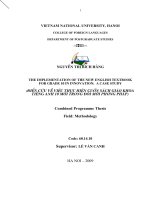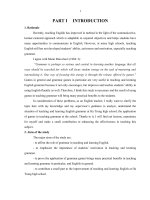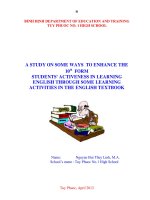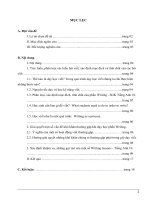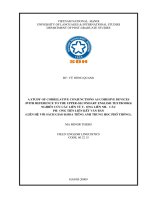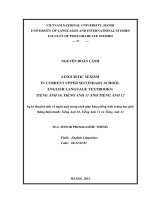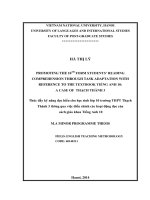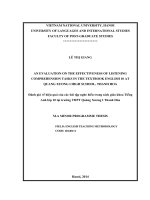Adapting English 10 textbook towards promoting learner's autonomy and communicative competence in learning grammar = Điều chỉnh sách giáo khoa tiếng Anh 10 theo
Bạn đang xem bản rút gọn của tài liệu. Xem và tải ngay bản đầy đủ của tài liệu tại đây (1.95 MB, 75 trang )
VIETNAM NATIONAL UNIVERSITY, HANOI
UNIVERSITY OF FOREIGN LANGUAGES AND INTERNATIONAL STUDIES
FACULTY OF POST-GRADUATE STUDIES
NGUYỄN THỊ HỒNG CHÂM
ADAPTING ENGLISH 10 TEXTBOOK TOWARDS PROMOTING
LEARNERS’ AUTONOMY AND COMMUNICATIVE
COMPETENCE IN LEARNING GRAMMAR
(ĐIỀU CHỈNH SÁCH GIÁO KHOA TIẾNG ANH 10 THEO HƯỚNG PHÁT HUY
TÍNH TỰ CHỦ VÀ TÍNH GIAO TIẾP TRONG VIỆC HỌC NGỮ PHÁP)
M.A. Minor Program Thesis
Field: English Teaching Methodology
Code: 60.14.10
Cohort: M.A 15
HÀ NỘI – 2010
VIETNAM NATIONAL UNIVERSITY, HANOI
UNIVERSITY OF FOREIGN LANGUAGES AND INTERNATIONAL STUDIES
DEPARTMENT OF POST GRADUATE STUDIES
NGUYỄN THỊ HỒNG CHÂM
M.A. Minor Program Thesis
ADAPTING ENGLISH 10 TEXTBOOK TOWARDS PROMOTING LEARNER’S
AUTONOMY AND COMMUNICATIVE COMPETENCE IN LEARNING GRAMMAR
(Điều chỉnh sách giáo khoa tiếng Anh 10 theo hướng phát huy
tính tự chủ và tính giao tiếp trong việc học ngữ pháp)
Field: English Teaching Methodology
Code: 60.14.10
Cohort: M.A 15
Supervisor: Cao Thúy Hồng, M.A
HÀ NỘI – 2010
4
LIST OF ABBREVIATION
OHP: Over Head Projector
CLT: Communicative Language Teaching
MOET: Ministry of Education and Training
LIST OF TABLES AND FIGURES
Figure 1: Components and domains of autonomy
Table 1: Grammar presentation in English 10 textbook
Table 2: Students‟ past learning experience
Table 3: Students‟ learning styles
Chart 1: Students‟ general judgments of grammar part in the new English 10 textbook
Chart 2: Students‟ opinion of the necessity to learn grammar
Table 4: Students‟ attitude toward learning English
Table 5: Students‟ preference to learn grammar
Table 6: Teachers‟ comments and suggestion for adaptation
Chart 3: Students‟ opinion of their English grammar learning at school
Table 7: Suggested activities for developing learner autonomy
5
TABLE OF CONTENTS
Page
Acknowledgement
Abstract
List of abbreviation
List of tables and figures
i
ii
iii
iv
PART ONE: INTRODUCTION
1. Rationale for the study
2. Aims and objectives of the study
3. Scope of the study
4. Method of the study
5. Organization of the study
1
2
2
3
3
PART TWO: DEVELOPMENT
Chapter I: Literature review
I.1. Overview of grammar learning and teaching
I.1.1. The importance of grammar in second language learning
I.1.2. Approaches and methods in teaching grammar
I.1.3. Grammar teaching in the CLT approach.
4
4
5
I.2. Overview of autonomy in language learning
I.2.1. The origin of autonomy
I.2.2. Definition of autonomy in second language learning
I.2.3. The importance of autonomy in second language learning
I.2.4. How to become autonomous in second language learning
7
7
9
10
I.3. Overview of learning attitude and learning style
I.3.1 Learning attitude
I.3.2 Learning style
13
13
I.4. Overview of textbook adaptation
I.3.1. Reasons for adapting textbook
I.3.2. Techniques for adapting textbook
15
16
I.5. Summary
16
Chapter II: The study
II.1. Situation analysis
II.1.1. The teaching and learning situation at Tu Da high school.
II.1.2 The teaching and learning methods
II.1.3. Constraints in teaching grammar in the CLT approach
II.2. The study
II.2.1 The participants
II.2.2. Instrument for collecting data
II.3. The findings and discussion
II.3.1 Evaluation of grammar activities in the English 10 textbook
II.3.1. Learners‟ past learning experience, learning attitudes and learning
strategies analysis
II.3.2. Needs for adaptation perceived by the students and teachers
II.3.4. Summary of the findings and discussion
17
18
19
21
21
22
27
32
37
Chapter III: Application
III.1 Aims and objectives of the adapted activities
III.2 Principles of textbook adaptation
III.2.1 Techniques of adaptation
37
6
III.2.2 Integrating learner autonomy training sessions into the regular curriculum
III.2.2.1 Building blocks of learner autonomy
III.2.2.2 Stages in the process of developing learner autonomy
III.3 The proposed adapted material.
III.4 Students‟ responses to the adaptation
37
39
39
40
42
43
Part three: Conclusion
1. Conclusion
2. Limitation of the study
3. Suggestions for further study
44
44
45
Appendix
Appendix 1: Student survey questionnaire 1
Appendix 2: Student survey questionnaire 2
Appendix 3: Follow up questions
Appendix 4: A copy of grammar lesson from English 10 textbook
Appendix 5: Sample adapted grammar lesson
Reference
List of abbreviations, tables and figures
7
PART ONE: INTRODUCTION
1. Rationale for the study
Over the last few decades, together with the rapid development of information technology
and economic growth, English as a Foreign Language has become an indispensable subject
in high school education program in Vietnam. However, the effectiveness of English
teaching and learning in different contexts vary to a great extent due to many factors. I
have decided to put the teaching and learning English at Tu Da High School, where I am
now teaching, under serious consideration for some reasons.
Firstly, my school has had moderate teaching and learning results for many years. On
average, the final English test scores are approximately below 4.2 on the mark 10 scales.
There are many factors accounting for this situation. One possible reason is limited
experience as well as moderate capacity of the five young English teachers there. Poor
economical condition also urges many students to spend more time working on the field
rather than concentrating on studying. However, from my point of view, in the context of
widespread and rapid development of information technology, the fundamental cause is not
the lack of teaching and learning materials but is that students do not know how to find
appropriate method for learning. In other words, the best solution is to make them become
autonomous in their learning.
Secondly, though up to now there have been non-stop debates on the definition of learner
autonomy, the fact that this concept is used widely indicating its significance in foreign
language learning specifically. It is mentioned in textbooks and syllabus of Great Britain,
France, Hong Kong, Singapore, for instance. In Japan, they have built a system of
Autonomous Centers where students can self-access the materials with or without teachers‟
guide. In Vietnam, this term of learner autonomy has recently been emphasized. In the
school year 2008-2009, the Education Minister, Nguyen Thien Nhan, gave out the slogan
“Towards a friendly school and autonomous learners”. Great improvements in building a
friendly school atmosphere can be witnessed nationwide. However, how to foster learner
autonomy in specific contexts is a difficult question.
Thirdly, while vocabulary is considered as the flesh, grammar is considered as the skeleton
of the body. Most formal English tests in Vietnam high schools basically focus on reading
8
skill and checking grammar and vocabulary knowledge. As a matter of fact, many high
school students consider their success in the grammar test as their goal of success in
learning English. The need to communicate is therefore underestimated. Furthermore,
teaching English grammar for grade 10 is the most challenging task for the teachers in my
school. My students come from several secondary schools nearby. After four years
learning English in their former schools, some have a considerable knowledge and skills
while others hardly knows anything about English.
For the above reasons, I have decided to focus my research on adapting the new English 10
textbook in the light of improving learning autonomy and communicativeness in learning
grammar.
2. Aims and objectives of the study
The study aims at finding the suitable principles of adapting English 10 textbook‟s
to improve students‟ autonomy and communicative competence in learning grammar.
The researcher defined the major objectives of the study as follows:
To investigate the grammar learning situation in the context of using new
textbooks at Tu Da high school
To evaluate the English 10 textbook‟s grammar parts in terms of learner
autonomy and communicative opportunity.
To search for the suitable adapting techniques in the textbook toward improving
learner‟s autonomy and communicative competence in learning grammar.
Research questions:
1. To what extent do the grammar parts in the new English 10 textbook help
learners to communicate and to improve their autonomy?
2. What are the principles for adapting the new English 10 textbook toward
improving learners’ communicativeness and autonomy?
3. Scope of the study
The study mainly focuses on the adaptation of English 10 textbook grammar to suit
the teaching and learning context of Tu Da High School only. It is based on the current
situation, learners‟ needs and teacher‟s opinions regarding sound literature findings.
9
4. Methods of the study
In order to successfully fulfill the tasks and achieve the objectives of the study,
attention should firstly be paid to students‟ learning styles, learning attitudes, preference
towards learning English grammar and teacher‟s and students‟ needs for adapting the
textbook. Data for the research was collected by means of survey questionnaires, informal
interviews and document analysis.
To identify the areas of adaptation, frequent talks and discussions with my teaching
staff were carried out after each unit‟s language focus lesson. On such occasion they were
asked to give their comments on the suitability of the grammar points in the lesson and to
give their suggestion for improvement.
To clarify the usefulness of the adaptation, informal interviews with the target
students as well as the teachers were also conducted.
5. Organization of the study
The study is divided into three parts which are briefly presented as follows:
Part I is the introduction which presents rationale, aims, scope, research method and
organization of the study.
Part II is the development of the study, consisting of the three chapters
- Chapter 1 provides the theory of grammar and grammar teaching in the light of
Communicative Language Teaching Approach, autonomy in language learning, learning
attitude, learning style and textbook adaptation.
- Chapter 2 presents the methodology of the thesis, focusing on the procedure of
adapting the textbook to improve learner communicativeness and learner autonomy as well
as constraints and recommendations for carrying out the project.
Part III is the conclusion which summarizes the overall study and states its limitations and
suggestions for further research.
10
PART TWO: DEVELOPMENT
Chapter I: Literature review
This chapter begins with a theoretical overview of grammar in the Communicative
Language Teaching Approach. Next comes with the overview of autonomy in language
teaching including the origin, definition, significance and ways to promote learner
autonomy. The last part introduces the reasons and techniques of textbook adaptation.
I.1. Overview of grammar learning and teaching
I.1.1 The importance of grammar in second language learning
Grammar plays an essential part in learning a foreign language as it gives us a means to
understand that language. Firstly, grammar reflects the order of the human thoughts and
helps us to understand the diversity of human culture. As for grammar supporters, the
acquisition of the grammatical system of a language remains the most important element in
language teaching. Secondly, teaching grammar helps students understand how the
language works as Harmer (1987) points out: „without some understanding of grammar,
students would not be able to do anything rather than understand separate items of
language for separate functions.‟ (p.2)
I.1.2. Approaches to grammar teaching
In general, there are two major approaches to teach grammar. They are: explicit grammar
teaching and implicit grammar teaching. In the traditional Grammar Translation Method,
grammatical phenomena are assumed to be wholly amenable to explicit presentation and
practice, according to which the teacher states directly right at the beginning of the lesson
what is learnt then. Vice versa, the implicit approach tends to lead the learners to the
grammar point through a series of steps – commonly known as „discovery technique‟.
Either of the two approaches has both advantages and disadvantages and suits different
types of learners.
Freeman (1986:150) points that
11
“Explicit teaching can speed up the learning of these features / patterns by making
them more salient, encouraging students to allocate attention to them by narrowing
learners‟ hypothesis space concerning their behavior. Explicit knowledge helps
students be able to be more accurate in expressing their ideas and thoughts
through teacher‟s monitoring what they speak or write. If they understand how a
grammatical feature functions, they will be more likely to notice it when listening
or reading.”
On the other hand, students seem to be more motivated and involved in learning when
grammar is taught implicitly. With the help of the teacher, learners are encouraged to
discover a particular grammar rule, to learn about a grammar point themselves. Motivated
students can easily and quickly discover the rules themselves, and remember much better
than the ones who are overwhelmed by grammatical explanations.
As seen above, either of the two approaches of teaching grammar is beneficial to some
extent. It is best to make a combination of the two. From the viewpoint of psycholinguistic
theory, providing learners with explicit instruction along with standard implicit exposure
would seem to be a no-lose position. Fotos, et al (1991) suggests designing conscious-
raising tasks in which students work interactively in small groups to solve grammar
problems in the target language. The role of the teacher is to help them become aware of
language rules whenever possible. It is more likely to be useful if the students can be
guided towards the reformulations of a rule than if it was explained to them.
I.1.3. Grammar teaching in the light of the communicative approach
In a traditional grammar - translation method class, lessons are taught in students‟ mother
tongue with little active use of the target language. Grammar rules are explained in their
mother tongue and students are expected to learn them by heart and make up sentences
according to these rules. The teacher is always the controller of students‟ activities in the
class while the students are only passive listeners and do what the teacher tells them to do,
which prevents them from producing the target language. This means that the lessons are
mainly teacher-centered, with teacher‟s detailed explanations and instructions. Although
the traditional grammar lesson is rather boring, the students seem to produce more correct
sentences and score high marks in the final tests. However, they have little chance to
communicate with each other. Normally learners speak with difficulty as they are afraid of
12
making mistakes. To be worse, students may feel tense, anxious and frustrated when they
communicate in the target language. In addition, the teachers also feel nervous when their
students have difficulty answering their answers, partly because teachers set up too high
expectations or because the teachers‟ questions are too difficult for the students. At the end
of the lessons, both learners and teachers may feel exhausted. This problem has been
pointed out by Le (2001). According to him, an inexperienced teacher does activities with
unclear and complicated instructions or goals about a target grammatical structure. He also
points out that Communicative Language Teaching (CLT) will help to solve the above
mentioned problem.
Smith (2001) claims that CLT grammar lessons are often organized based on language
functions with cross references to linguistic forms, which is a fresh perspective to grammar
teaching. The focus is thus altered: on both functions and forms. Grammar should be
treated through communicative contexts and should be based on discourse, both orally and
in writing. In broader terms, through linguistic analysis of language use in a particular
setting, students know how to use language to communicate. Celce-Murcia et al (1988)
state that discourse analysis offers knowledge underlying the use of language in natural
contexts to communicate and explore intended meaning, which is one of the principal
concerns of CLT nowadays.
According to Nunan (1991), an inadequate knowledge of grammar constraints linguistic
creativity and limits the capacity for communication. Many teachers underestimate the role
of grammar in communication and thus unintentionally restrict students‟ creativity in
successful communication. We can see that the communicative approach enables students
to study and practice not only communication skills, but also grammar patterns. The role of
students also changes; now they become the central in the language classroom. During the
lesson, students are encouraged and led or guided to explore the meaning, rules and use of
a grammatical items. Grammar points, therefore, are not explained explicitly. Instead, they
are taught in a living, context-embedded way with its use. Students are allowed to
communicate using the target grammatical items via games and communicative activities.
The teachers try to help students in any way to set them involved in the activity right from
the beginning. Students are expected to be responsible for their learning. They have chance
to negotiate and cooperate with each other.
13
However, the grammar teaching in Vietnam now follows several methods and different
approaches. A lot of teachers follow traditional structural approaches and others favor the
communicative one. In short, teaching English in the light of CLT now face with
considerable constraints due to several factors. The study below will examine the
implementation of CLT approach under the new English 10 textbook‟ grammar part and
gives suggestions for adapting the textbook so as to make it more communicative.
I.2. Overview of autonomy in language learning.
I. 2. 1 The origin of autonomy
The origin of „autonomy‟ goes back to the Greek word „autonomous‟ which was initially
applied to territory or city-states. Resembling the Latin-based equivalence „self-
regulation‟, autonomy refers to the condition of being self-ruled, or capable of regulating
one‟s own thoughts, learning and actions (Oxford, 2003)
Finch (2001) from Hong Kong Polytechnic University made a careful investigation into the
history of this theory. In the late 1960s, many industrially advanced Western countries
defined social progress in term of improvement in “the quality of life”, giving rise to
various kinds of social awareness, from ecology to the status of women, the rights of
patients and education. In second language learning, this humanistic trend resulted in
various socio-linguistic disciplines which all shared a pragmatic vision of language as “a
tool for communication”_ the rationale for the “Communicative Approach” to language
learning and teaching. Another outcome was the “deschooling education” movement of the
1970s. Later on, in the 18
th
century, the concept of individual autonomy was central to
European liberal-democratic and liberal-humanist thought. A number of learner-centered
approaches emerged in the 1980s and 1990s, all of which include autonomy and
independence of learning among their aims: the learned-centered curriculum (Nunan
1988), the negotiated syllabus, learner training (Dickinson 1992), learning-strategy training
(Oxford, 1990), the project-based syllabus (Legutke & Thomas 1991), experiential and
collobarative learning (Nunan 1992) and learner-based teaching. These can be seen as
growing from early work on learner autonomy, which was developed in the 1980s. Since
the Second World War, the need to adapt to the rapid changes in technology,
communications and employment has lead to great changes in educational philosophy,
language-learning theory, and political belief. Therefore learning to learn is now more
14
important than knowledge. Autonomy has thus become a popular focus of foreign
language teaching, supported by a general educational concern to help students become
more independent in how they think, learn and behave.
I.2.2 Definition of learner autonomy in second language learning.
Oxford (2003) notices that controversy exists even in the most elementary terminology of
learner autonomy. Dickinson (1987) views autonomy as a learning condition while Holec
(1983, p.3) interprets it as learners‟ ability and attitude of responsibility and „self-directed‟
is referred to as the learning situation or mode. Little (1991) shares the same point of view
with Holec (1983). He supposes that autonomy is recognition of the rights of learners
within the educational system. “Learner autonomy is a capacity for detachment, critical
reflection, decision making, and independent action”. (Little, 1991, p.4)
Benson (1996, p.27) in his article discusses the four dimensions of autonomy: individual,
political, social and psychology. Individual autonomy stresses individual learning styles
and preferences. In this form of autonomy individual choices take precedence over
collaborative learning. In contrast, social autonomy recognizes that learning takes place
through interaction and collaboration, as well as through individual reflection and
experimentation. A psychological view of capacities of the learner focuses on the
importance of the psychological or „internal‟ capacities of the learner, such as cognitive
and learning styles, motivation, attitudes, aptitude and so on. There is a focus on the
learners‟ responsibility for their own success and failures in learning. In contrast, a
political view of autonomy has, as its prime goal, a political end, and the learning process
is shaped by this.
Littlewood (1996) divides autonomy into three spheres, namely autonomy as a
communicator (the ability to use the language creatively and to use appropriate strategies
for communicating meanings in specific situations), autonomy as a learner (the ability to
engage in independent work and to use appropriate strategies, both inside and outside the
classroom) and autonomy as a person (the ability to express personal meanings and to
create personal learning contexts). Though these concepts are new by their name, they are
15
all based on a belief in a developed self (self-conscious, rational being able to make
independent decisions), and an emphasis on freedom from external constraints.
Since the abilities to communicate and learn independently are major factors in
enabling a person to make choices in life, they also contribute to each learners'
autonomy as an individual. (Littlewood 1996, p.429)
The components and domains of autonomy in foreign language learning by Littlewood
(1996) is illustrated in the below figure, pointing out that there are different levels of
autonomy in each domain. Nunan (1996) and Dickinson (1987) also acknowledge degrees
of autonomy, depending on the personality of the learners, their goals, the philosophy of
the institution and the cultural context.
Motivation,
Confidence
Knowledge,
Skills
Willingness
Ability
To make and carry out choices in
Specific tasks
Life in general
Autonomy as
communicators
Autonomy as
learners
Autonomy as
persons
Figure 1: Components and domains of autonomy. (Littlewood 1996, p.430)
To sum up, there have existed different ways of understanding what learner autonomy is
up to now. However, it must be agreed upon that linguists worldwide have tried their best
to fulfill the definition and they seem to reach to an almost final common one. So far, it can
be concluded that an autonomous learner is the one who can regulate his own thoughts,
learning and actions. Besides, he must be capable of engaging in independent work, using
appropriate learning strategies and to create personal learning contexts, both inside and
outside the classroom. Finally, he is supposed to be able to express personal meanings in
both learning and in real life. So as to achieve these goal, learners should be given the
chances to interact, collaborate, reflect and experiment him through first in specific
learning tasks and then in life in general. As an instructor, we should take into
consideration the psychological or internal capacities of the learner such as cognitive and
learning styles, individual preference, motivation, attitudes and aptitude, and so on.
16
I.2.3. The importance of learner autonomy in second language learning
Autonomy can be seen as the fundamental factor for the success of a language learner as an
old saying goes: “you can bring the horse to water, but you cannot make him drink.” In
language teaching, teachers can provide all the necessary circumstances and input, but
learning can only happen if learners are willing to contribute”
“… in order to master another language, you need to be personally involved. You need
to play with the language to develop a feeling of how it works. The language must, in
some sense, become a part of you rather than an external mechanical system that you
manipulate according to a set of instruction” (Scharle & Szabo 2005, p.2)
Scharle & Szabo (2005) supposes learners must be responsible for their study outcome.
“You, the language learner, are the most important factor in the language learning process.
Success or failure will, in the end, be determined by what you yourself contribute.‟ (p.6)
Furthermore, if motivation is the key to success for a learner of a foreign language,
autonomy itself implies motivation. “If learners are proactively committed to their
learning, the problem of motivation is by definition solved; although they may not always
feel entirely positive about all aspects of their learning, autonomous learners have
developed the reflective and attitudinal resources to overcome temporary motivational
setbacks” (Little, 1991, p.4) In other words, if successfully fostering learner autonomy in
the classroom, teachers will have the students who are self-motivated. According to Little
(1991), although autonomous learners may not always feel entirely positive about all
aspects of their learning, they have developed the reflective and attitudinal resources to
overcome temporary motivational setbacks.
I.2.2.4 How to develop learner autonomy
Similar to ways of defining learner autonomy, various methods of developing learner
autonomy have been suggested basing on the stand on which linguists view autonomy.
In the 1970s, most language teaching methodology was teacher-centered, the most
common activities were translating a passage, memorizing a rule, or repeating a dialogue.
Then the value of learner autonomy was discovered in the form of allowing learners to do
things like initiating oral production, problem solving in groups, pair work practicing, and
so on. It is not until recently that the three interrelated concepts of “autonomy, awareness
17
and action” have played an increasing significant role in learner‟s development,
particularly with greater pedagogical emphasis on learner-centered language teaching
(Wenden, 2002). The availability of the “self-help” manuals in almost every field of life,
including language teaching and learning encouraged learners to “take charge” of their
own learning, and to chart their own “pathways to success” (Brown, 1989). Studies on the
courses which help learner aware of their learning process showed that learners can indeed
benefit from these awareness-raising activities (Brown, 2007). Last but not least is the
action step as “awareness without action will be relatively useless” (Brown, 2007). After
learners have been aware of their own learning style, strengths and weaknesses, they can
take on appropriate strategy. (Brown, 2007, pp. 131-132)
From cultural perspective, Pennycook (1997) warns that autonomy is not a universe good
as it depends on each culture values. But he claims that the goals as language educators is
an attempt to teach language in a way that opens up culturally alternatives for our students,
that allow them to become authors of at least part of their world. Schmenk (2005) states
that learners for a non-Western cultures should be critically aware of specific cultural
backdrops.
Allwright (1990), from the viewpoint of psychology, claims that autonomy concerns the
attitude of willingness to take responsibility, the necessary ability, and concrete action.
Meanwhile, Pennycook (1997) supposes autonomy takes in more perspectives such as:
technical perspective (focus on the physical situation), psychological perspective (focus on
characteristics of learners), sociocultural perspectives (focus on mediated learning) and
political-critical perspective (focus on ideology, access, and power structures).
Dickinson‟s (1987, p.11) definition of autonomy also illustrates the technical perspective:
“the situation in which the learner is totally responsible for the decisions concerned with
his/her learning and the implementation of these decisions. In full autonomy there is no
involvement of a teacher or an institution […] [nor] specially prepared materials.” Mc
Carthy also proposes designing a summer language course by building a self-access centre,
project work and explicit training in learning strategies. Meanwhile, Little (1991) interprets
that learner autonomy is “a holistic view of the learner that requires us to engage with the
cognitive, metacognitive, affective and social dimension of language learning and to worry
about how they interact with one another”.
18
As for Smith (2003), an appropriate methodology needs not to be referred from a prior
generalization. Autonomy itself is not a new method or that its promotion does not entail
particular procedures or technology, either. But it can be developed by teachers for their
own teaching contexts. He recommends two versions of pedagogy for learner autonomy
basing on his own teaching experience with students in a Japanese university for seven
years. The „weak‟ version follows a product-oriented approach, which tend to view
autonomy as a capacity students currently lack and they need to be prepared to. The
rationale may tend to come from research into beliefs regarding „good language learners‟.
The „strong‟ version, on the other hand, adopts on an experiential and process-oriented
approach, which based firmly on students‟ own experiences and insights as the teacher has
assumed that students are, to greater or lesser degrees already autonomous.
In her own context, Foseka (2003) suggests introducing language in a way that can satisfy
learners‟ current needs. Mastering the target language, going abroad or talking with native
speakers is out of their reach in a poor country so she suggests using song to improve
learners‟ autonomy. Islam and Mares (cited in Tomlinson, 2007, pp.89-90) further add that
learners should be given a chance to discover the target language rules and conventions
themselves and reading and listening tasks should be selected to cater for learner‟s
preference, not just to check comprehension either with or without teacher‟s guidance.
All things considered, lack of autonomy is the fundamental cause for loss of success
among my students. It can be inferred that the most suitable pedagogy in my own teaching
context then is a product-oriented approach, which sees autonomy is what they need to be
prepared for. The procedure is divided into several stages such as raising awareness and
taking action. In the former phase, students are taught to be aware of their learning styles,
strengths and weaknesses so as to take appropriate strategy. I am with Little‟s (1991) and
Pennycook‟s (1997) opinions that we should take a holistic view of the learner when
considering learner autonomy. Autonomy among learners is supported comprehensively by
technical, psychological, sociocultural factors and so on. Besides objective factors such as
learning preference, learning styles and motivation, a self-access centre with abundant
reference books at hand, English club, play no less important role. With regard to grammar
teaching materials, the contents and activities should be selected to cater for learner‟s
preference and they should be given a chance to discover the target language rules and
convention themselves. Last but not least, grammar learning should be fun and realistic,
19
that is, the students are to be given chance to interact meaningfully and learning must be
related to their daily life.
I.3. Overview of learning styles and learning attitude
It can be inferred that CLT approach considers a successful ESL learner as a successful
communicator in that language. With the viewpoint of taking the learner as the centre of
the teaching and learning process, the teacher‟s initial and utmost important job is to keep a
thorough understanding of the learner‟s factors such as learning attitude and learning
styles. The next coming part serves to clarify the above concepts.
I.3.1. Learners‟ attitude
Hallorah (1967) defines attitude as an individual‟s like or dislike for an item. Attitude
therefore is classified into positive, neutral and negative views of an object. Gibb and
Fazio (1988) give out more detailed definitions. According to Gibb (1988) , attitude is
generally a state of mind, which is influenced by feelings, experiences of the world and
beliefs. Fazio (1988) states that attitude comprises three components namely affective,
cognitive and behavioral. The affective component can be easily assessed by monitoring
physiological signs such as heart rate whereas the behavioral aspects may be observed
directly. The cognitive side is generally measured by interviews, survey and other
reporting methods.
As for Hovland (1973) attitude in language learning changes responsively according to the
learner‟s satisfaction in communication. One will normally keep positive attitudes if the
communication is successful and interesting. Otherwise, negative attitude will be formed if
the communication is unsuccessful and unattractive. The success of communication
depends on several factors such as the communicator‟s interest in the topic, frequent
change of topics or the maximum use of language use in every task. Hollorah (1967, pp.
60-61) shares the same point of view with Hovland. He states that people always adopt,
relinquish and modify attitudes to fit the ever-changing needs and interests. Simple
education can‟t change attitudes. Acceptance of new attitude depends on who presents the
knowledge, how it is presented, how the person is perceived, the credibility of the
communicator, and the condition by which knowledge is received. Sherif (1975, p.15) and
Hollorah (1976, pp. 60-61) further find out that attitude change also depend on the
learner‟s personality characteristics such as susceptibility to persuasion, intelligence,
20
readiness to accept change, and so on. In 1968, McGure develops steps to change an
attitude begging with attention, comprehension, retention, yielding then action. Thus he
supposes attitude can be changed by a number of sources including other people, media,
family and other subject.
In studying a foreign language in particular and other subjects in general, students may
become bored and inattentive in class, do badly on tests and get discouraged from the
courses or even drop out of school if the students keep poor attitudes in learning. Attitude
and learning go hand in hand. Garber and Lamber (1972) all agree that “success in
mastering a foreign language would depend on not only intellectual capacity and language
aptitude, but on one‟s attitudes towards representatives of that language as well.” In fact,
attitude plays an important role in students‟ learning. If they maintain a positive attitude,
they will carry out their learning to the best of their ability and vice versa. Students‟
attitudes have an effect on their behavior, learning style and learning results. Lightbrown
and Spada (1999) state that attitude is fundamental to the success or failure that we
experience in learning. Depending on the learners‟ attitudes, learning language can be a
source of enrichment or resentment. Likewise, Brown (1994) says that language learners
benefit from positive attitude while negative attitude may lead to unsuccessful attainment
of proficiency.
I.3.2. Learning styles
Students‟ learning style is one of the factors we should take into consideration to see the
particular approach by which students try to learn. Major factors conditioning ways
students think and study are the educational system, the socio-cultural background and
personality variables. In Reid‟s opinion (1987, p.100), learning styles are modeled as
„strong habits rather than intractable biological attributes‟. He classifies learning styles into
categories namely, visual, auditory, kinesthetic, tactile, group and individual learning as
follows:
Visual learners learn alone with books, remember and understand information
and instruction if they read them.
Auditory learners prefer to listen to lectures or audio tapes, and remember
information by reading aloud or by moving lips as they read.
21
Kinesthetic learners remember information and learn well when involved
physically in classroom activities such as role-playing or taking part in
communicative games.
Tactile learners can learn and remember information better if they wrote notes or
instructions when they work on experiments in a laboratory and build model.
Group learners learn more easily when they work with another learner or more.
They understand and remember information through interaction and class work.
Individual learners remember and understand better if they work alone.
(Reid, 1987)
I.4. Overview of textbook adaptation
I.4.1. Reasons for adapting textbook
Although most classroom teachers will not be involved in the production of textbooks, all
teachers have the responsibility for textbook evaluation, selection and adaptation. Despite
the great effort that textbook writers make to meet the needs of the intended users,
textbooks are subjective to adaptation when they are actually used in the classroom.
Mc Donough claims that the purpose of adaptation is to personalize, to individualize,
localize or modernize the classroom materials so that they are more appropriate for specific
learners. Islam and Mares (2007) add further objectives such as to add real choice, cater for
all sensory learner styles, provide for more learner autonomy, encourage higher-level
cognitive skills, make the language input more accessible and encouraging. (Islam &
Mares, 2007, cited in Tomlinson, 2007, p.89)
I.4.2. Techniques for adapting textbook
Textbook adaptation can be done at three levels. The first level is macro adaptation, which
is ideally done before the language program begins. After comparing what is covered in a
textbook and what is required by the syllabus or examination, the teacher may find that
certain areas or even whole units of the book can be omitted, and certain contents need to
be supplemented. Macro adaptation is very important because it helps the teacher to avoid
waste of time for both the teacher and the students as well. It also helps the teacher to see
in advance what he or she needs to supplement so that he or she can keep an eye on
materials that could be used. The second level of adaptation is adapting a unit. This could
be reordering the activities, combining activities, omitting activities, rewriting or
22
supplementing exercise material, etc. Unit adaptation helps to make the classroom teaching
more smooth and cohesive. It also helps the teacher to better fulfill the aims of a unit. The
third level is adaptation of specific activities in a unit. Occasionally an activity is regarded
as valuable, but it is not well-designed or it is not feasible in particular class. If the teacher
does not want to give up the activity, he or she needs to adapt it
In the context of teaching the English textbook at high school in Vietnam, the teachers
have to comply strictly with the teaching curriculum suggested by the Ministry of
Education. Furthermore the new textbook has been evaluated to be generally suitable for
high school pupils in the whole country. Therefore, the textbook adaptation is usually
carried out with specific activities within a unit.
The most common ways of textbook adaptation are normally suggested as follow:
Omission: the teacher leaves out things deemed inappropriate, offensive,
unproductive, etc. for a particular group.
Addition: where there seems to be inadequate coverage, teachers may decide to
add to textbooks, either in the form of texts or exercise material.
Reduction: where the teacher shortens an activity to give it less weight or
emphasis.
Extension: where an activity is lengthened in order to give it as additional
dimension. (For example, a vocabulary activity is extended to draw attention to
some syntactic patterning.)
Rewriting/modification: teacher may occasionally decide to rewrite material,
especially exercise material, to make it more appropriate, more “communicative”,
more demanding, more accessible to their students, etc.
Replacement: text or exercise material which is considered inadequate, for
whatever reason, may be replaced by more suitable material. This is often from
other resource materials.
Re-ordering: teachers may decide that the order in which the textbooks are
presented is not suitable for their students. They can then decide to plot a different
course through the textbooks from the one the writer has laid down.
23
Branching: teachers may decide to add options to the existing activity or to
suggest alternative pathways through the activities. (For example, an experiential
route or an analytical route.)
(Islam & Marie, 2007)
I.5. Summary
This chapter presents an overview of the theories related to learner autonomy in learning
and textbook adaptation. The grammar parts in the new English 10 textbook are adapted
with an aim to increase learner autonomy and provide more communicative opportunities
for learners. The specific techniques and actual procedures and results are discussed in the
next chapter.
24
Chapter II: The study
II.1 Situation analysis
II.1.1 The teaching and learning situation at Tu Da high school
English is one compulsory subject and is taught in three or four forty-five minute‟s periods
per week. All students enter high schools with four year‟s prior experience studying
English in lower secondary school. However, most of them do not have a clear cut purpose
in learning English and they are likely to be passive in learning English.
The class size is generally from 40 to 45 students in each classroom which is poorly
equipped with blackboard and long desks for four students. This makes the teacher difficult
to apply technology and to organize group work. Most of the time in grammar lessons is
spent presenting, explaining grammar principles. Learners take note, memorize, acquire
knowledge passively and have little chance for developing language skills. From the
researcher‟s observation, due to time limit, teachers only exploit language data presented in
the textbook. Learners listen to the teacher and repeat passively and mechanically.
Teachers test learners‟ understanding by asking them to translate into or explain in
Vietnamese. In short, English teaching at Tu Da high school for a long time has not
achieved its target for a long time for several reasons. Teachers typically provide learners
with a large a mount of academic knowledge and make light of language practice while
learners take notes and acquire language passively. Thus, it unfavorably affects the quality
of teaching and learning English. In addition, the lack of reference resources from school‟s
library is another problem which deprives learners the opportunity for independent
learning. The classrooms are too large, noisy and uncomfortable. Modern teaching
facilities like OHPs, whiteboards or language laboratories and computers are sometimes
available, but rarely in operation.
These shortcomings directly affect the effectiveness and quality of English teaching in my
school context. Thus it poses the need to innovate teaching and learning methods.
25
II.1.2 Teaching and learning method
Teaching methodology
For many teachers, any alternation to the lessons in the textbooks is considered „insecure‟
or „risky‟. The difficulties for change may result from teacher‟s limited and even
misleading knowledge about the new methods and techniques. Due to time constraints, the
short-time workshops (lasting one day to a week) organized by the MOET have not
provided the teachers with thorough understanding of the communicative method. Despite
the fact that they are aware of some values in communicative methodology, they hesitate to
incorporate these new methods into their own classrooms.
As shown from the literature review, students can learn effectively when they take part in
actively in the communication with the target language rather than only passively
accepting what the teachers say. Brown (1991) reveals that a language learner can, and
must, take control of his/her own language learning and assume responsibility for his/her
success or failure. However, for fear of being unable to control the chaotic, noisy students
as well as of the challenge to the structure teacher-learner relationship, the most common
method is questioning and answering. Teacher reads the question and calls one individual
to answer, instead of assigning pair or group learning activities. Teacher-learner is the
usual model of interaction. This teaching methodology fails to create a favorable learning
atmosphere that allows the learners to communicate freely. Due to the teachers‟ hesitation
to change their habits, language classes in Tu Da high school remain lecture-oriented or
teacher-centered, with the focus on grammatical items and translation.
Learning method
From my own observation, most pupils in my school still stick to the traditional passive
learning method. What the students attempt to do is to attend class, listen to the teacher‟s
explanation, take notes and memorize everything. The concept of learner autonomy or
learner independence seems to be very new. Consequently, many students obtain good
exam grades as a result of their knowledge of language structures but fail to communicate
effectively in real life.
Being located in the countryside, almost all pupils come from rural villages nearby. The
moderate economic situation hinders them from receiving modern teaching and learning
facilities such as computer, the online internet, reference books or even the new textbooks.
26
They have to buy old textbooks and almost all the exercises are already done. To be worse,
some students often copy the answer key from “Để học tốt Tiếng Anh 10”, or copy the key
from other class members as they are fear of the teachers.
II.1.3 Constraints in teaching communicative grammar
Testing and evaluation
According to the information given by the teachers, most of them find it hard to design
appropriate exercises for large and multi-level classes so it was not easy to meet the
communicative needs of every student. Moreover, the rigid requirement of the curriculum
with fixed timing forces them to discard teaching communicative grammar and limit their
innovation as well. As long as a majority of high school pupils are still heavily influenced
by the testing pressure and the Listening and Speaking skills are not tested formally, a lot
of students only focus on learning grammar rules and vocabulary. They do not have an
actual and obvious communicative need which results in little efficiency when the
communicative approach is applied to teaching grammar.
Language environment
Real-life environment is also an obstacle to teaching communicative grammar. In the
countryside areas, English only arises in the classrooms. Furthermore, it is just one among
more than ten subjects in the class‟s curriculum. Thus, it can be concluded that the students
do not have much chances to practice English outside class. As Ellis (1996) states that
without the reinforcement of an English-speaking environment, motivation becomes a
product of teacher‟s initiatives. The teacher is expected to be the sole provider of
experience in the target language. Lacks of exposure to the target language and the exam-
stricken custom to some extent have hindered student‟s motivation. Intrinsic motivation in
some cases is replaced by the fear of failure in exams. In many high schools, failure in
exams is supposed to be an academic incompetence and a face-losing misfortune. Teacher
are assumed to be responsible for the low pass rate of their students‟ performances in
public examinations so a teacher‟s utmost mission is to make sure that their students
achieve high pass rates in the exams.
Classroom conditions
As Pennycoook (1997) points outs, autonomy takes in more perspectives rather than the
inner factors of the learner. Therefore it is necessary to count on technical, psychological,
